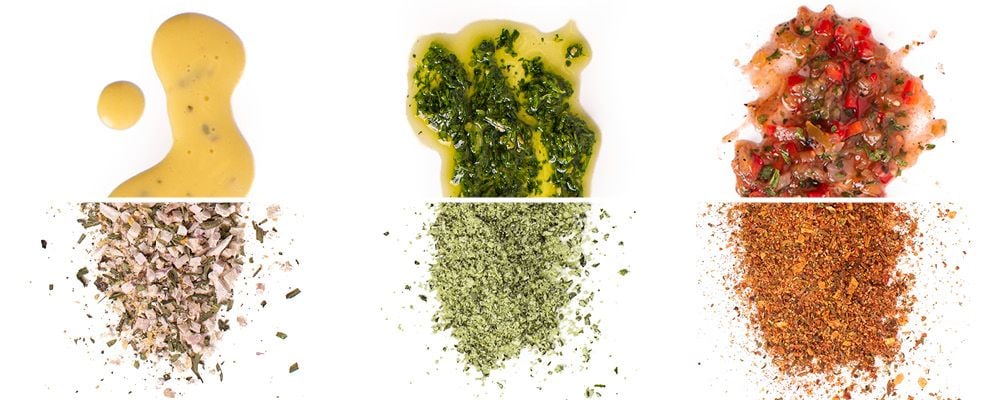First, let’s go back in time: back when Janet and I opened our first shop down on Platte street in late 2004. We found that in order to get the best spices, we often had to buy much larger quantities than we were confident we could sell through. It was the barrier of entry and we had little choice. Quickly though, we discovered that blending those spices into our own mixes was the best way to overcome this problem. Having a wide range of seasonings meant we give our customers more choices AND that we rotated through inventory more quickly, which meant our spices were always fresh—a critical factor for us.
Okay, I admit that I selfishly loved this solution: it was a creative outlet, which kept my mind off the struggles we were facing each day as we were building our own small business. Like I mentioned above, sauces came as a huge source of new seasoning ideas—think harissa, chimichurri and many others. For now though, let’s just focus on three that were created in those early days: Tarragon Shallot Citrus Seasoning, Parmesan Pesto Sprinkle, and Cuban Island Spice.
Tarragon Shallot Citrus Seasoning

Shop Tarragon Shallot Citrus Seasoning
Freeze dried shallots and tarragon were two of those large-volume spices. As straight spices, each were kind of slow sellers. They were ingredients in a few blends: shallot’s delicate texture and aromatic flavor were critical to our top-selling Capitol Hill Seasoning and our unique Shallot Salt while tarragon’s savory, licorice notes added depth to our Herbes de Provence and balance to our Fines Herbs. We needed a few more options though, so I set out to create a spice blend that would use both as the primary flavor.
Knowing both flavors were often used in French cooking, that’s where I started digging around for inspiration. As you might have read in Ashlee’s guide, the French are big on using sauces to build flavors, often using them instead of spice blends. They do have a few, like the above-mentioned Herbes de Provence as well as Fines Herbs, and Vadouvan (a French curry) of which we made a dried version of the traditional fresh bundle. So, finding another seasoning lead to a dead end…
But that’s when the ghost of the 1830’s chef and restaurateur Jean-Louis Francoise-Collinet tapped me on the shoulder (the Platte street shop is notorious for its ghost inhabitants) and whispered in his French accent “dude, you should be creating a dry version of the sauce I invented: béarnaise sauce. It totally uses shallots and tarragon”. Of course, I coolly responded “Merci beaucoup, Jean-Louis!” (because I ain’t afraid of no ghosts). Boom! Tarragon Shallot Citrus Seasoning’s flavor came together pretty quickly. That’s just how inspiration happens sometimes… wink!
Parmesan Pesto Sprinkle
Sometime around the 16th century in a northern region of Italy called Genoa, pesto sauce was created. The basic sauce recipe has stood the test of time—crushed basil, garlic, and pine nuts that are blended with Parmesan cheese and olive oil. The Genoese word “pesta” means to pound or crush, which refers to how the original sauce was made using a mortar and pestle. When I first created our original version, we had pine nuts included in the seasoning. We called it Pine Nut Pesto at the time. With the increase in nut allergies, however, we made the decision to remove them many years back—but its popularity never wavered amongst our customers. There is something about the sauce’s simplicity and alluring aroma of basil that is so approachable and enticing. I just kept that simplicity in mind (no ghost inspirations needed) and stuck to the longstanding formula when creating our dry version of this amazing Italian sauce.
Cuban Island Spice
The idea of creating a Cuban-inspired seasoning was brought to me by Melinda, a longtime Savory Spice employee. She now handles some of our relationships with restaurants across Denver, but while she was working at our Lowry shop, she thought that our product line had something missing and that I could fix it. Challenge accepted!
When I think of Cuban cuisine, I think of sofrito, mojo, and adobo. And, of course Cubano sandwiches (but that’s a topic for another day). To create a blend of the three, my first step was to convert the elements of sofrito sauce into a dry spice version. Luckily, all the main fresh ingredient in this traditional sauce were already available to me as dry ingredients: tomatoes, bell peppers, onions, and garlic. Check! Got those covered. The real trick for creating the seasoning I was envisioning was finding the right elements mojo sauce and adobo to include (and at the right proportions). The annatto and lime flavor in a mojo sauce were a must, as were the cumin and oregano of an adobo seasoning. I sprinkled in a couple other spices for balance and Cuban Island Spice was born. Melinda was right! Ever since we started stocking it on our shelves, it has been a Top 30 product—which is pretty darn impressive considering we have over 450!
There you have it—a little history on how sauces have inspired the creation of seasonings here at Savory Spice. Look out for my blog in August when I’ll talk about how some hot sauces have done the same! In the meantime, do you have any ideas for other sauces you think would be cool as seasonings? Be like Melinda (and the ghost of Jean-Louis Francoise-Collinet) and share your thoughts with me by commenting below or tagging us with a pic of the sauce you think we should make into our next great seasoning.
